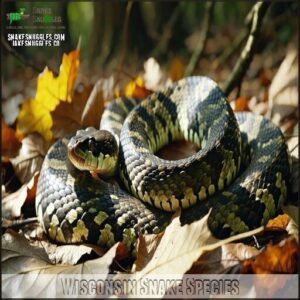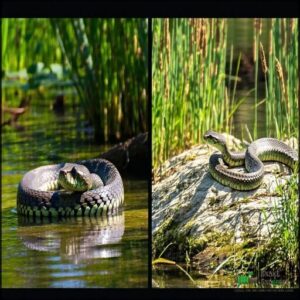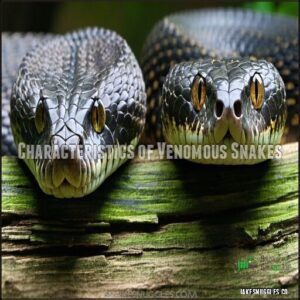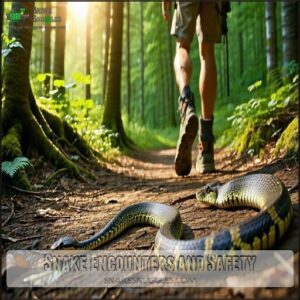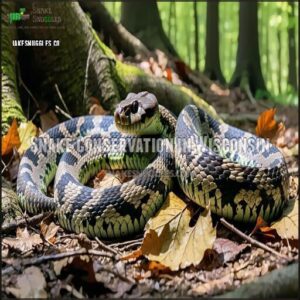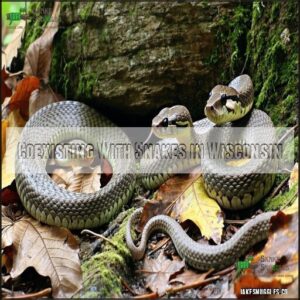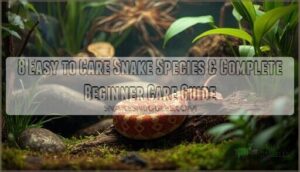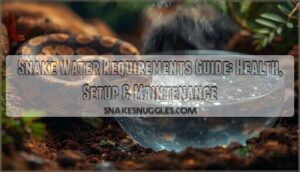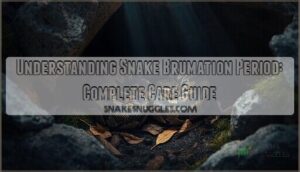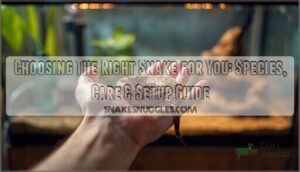This site is supported by our readers. We may earn a commission, at no cost to you, if you purchase through links.
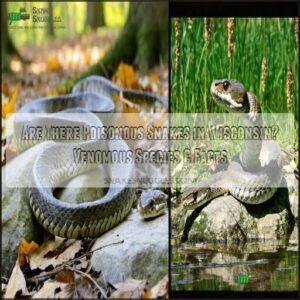
You’ll only find two venomous species: the timber rattlesnake and the eastern massasauga (nicknamed the "swamp rattler").
Both prefer specific habitats – the timber rattlesnake inhabits rocky bluffs in southern and western Wisconsin, while the endangered massasauga sticks to wetlands in a few isolated areas.
You’re unlikely to encounter either during typical outdoor activities, as they generally avoid humans.
Most Wisconsin snakes you’ll meet are harmless garden varieties just looking to keep their distance.
Knowing how to identify these rare venomous residents can make your outdoor adventures both safer and more informed.
Table Of Contents
- Key Takeaways
- Wisconsin Snake Species
- Snake Habitats and Distribution
- How to Identify Wisconsin Snakes
- Snake Encounters and Safety
- Snake Conservation in Wisconsin
- Snakebite First Aid and Treatment
- Wisconsin’s Deadliest Snakes
- Snake Myths and Misconceptions
- Coexisting With Snakes in Wisconsin
- Frequently Asked Questions (FAQs)
- How many venomous snakes are there in Wisconsin?
- Are there rattlesnakes in Wisconsin?
- Are fox snakes venomous in Wisconsin?
- Are garter snakes venomous in Wisconsin?
- Are there snakes in Wisconsin?
- How do you know if a snake is venomous in Wisconsin?
- Where are poisonous snakes found in Wisconsin?
- Are there copperhead snakes in Wisconsin?
- Are there water moccasin snakes in Wisconsin?
- What 3 states have no venomous snakes?
- Conclusion
Key Takeaways
- You’ll find only two venomous snake species in Wisconsin: the timber rattlesnake and eastern massasauga (swamp rattler), both belonging to the pit viper family.
- You can identify Wisconsin’s venomous snakes by their triangular heads, heat-sensing pits between eyes and nostril, vertical pupils, and distinctive rattles on their tails.
- You’re unlikely to encounter these venomous snakes as they prefer specific habitats – timber rattlesnakes inhabit rocky bluffs in southern/western regions while massasaugas stick to wetlands in isolated areas.
- You’ll stay safer by wearing closed-toe boots, sticking to designated trails, and maintaining a safe distance if you spot a snake – remember that Wisconsin averages only one rattlesnake bite every four years.
Wisconsin Snake Species
You’ll find 21 snake species across Wisconsin’s diverse habitats, though only two—the Timber Rattlesnake and Eastern Massasauga—are venomous.
Wisconsin’s forests and wetlands host 21 snake species, with only the Timber Rattlesnake and Eastern Massasauga posing venomous concern.
When exploring Wisconsin’s woodlands, wetlands, or grasslands, you’re much more likely to encounter harmless species like garter snakes or fox snakes that help control local rodent populations.
Common Non-Venomous Snakes
Wisconsin’s slithering residents include 19 harmless snake species that vastly outnumber their venomous relatives.
As you explore the state’s diverse landscapes, you’ll encounter these common non-venomous Wisconsin snakes in various habitats.
The most frequently observed non-venomous snake species include:
- Common Garter Snake: Identified by its distinctive yellow stripes and variable body markings, often found in grassy areas
- Eastern Fox Snake: Often misidentified due to its tail-vibrating defensive behavior, reaching 3-5 feet in length
- Eastern Milk Snake: Displays red, black, and cream bands with unique body markings
- Northern Water Snake: Frequents common habitats near lakes and streams, with a diet variety including fish and amphibians
- DeKay’s Brownsnake: A small snake (7-13 inches) with round pupil shapes, commonly found in gardens
Snake size varies considerably among Wisconsin snakes, from the tiny 7-inch Brownsnake to the impressive 6-foot Bullsnake.
Learning to identify these beneficial creatures by their distinctive patterns becomes easier with practice.
Venomous Snakes in Wisconsin
Moving beyond harmless serpents, Wisconsin hosts exactly two venomous snake species that deserve your attention. Both the timber rattlesnake and the eastern massasauga belong to the pit viper family, identifiable by their triangular heads and heat-sensing pits.
| Species | Size | Habitat |
|---|---|---|
| Timber Rattlesnake | 36-60 inches | Rocky bluffs, western Wisconsin |
| Eastern Massasauga | 20-32 inches | Wetlands, southern/central regions |
Timber rattlesnakes display yellowish-brown bodies with dark chevron patterns, while the smaller massasauga (federally threatened) features a gray body with dark blotches. Despite their venomous capability, rattlesnake bites in Wisconsin are exceedingly rare—roughly one incident every four years.
These reclusive creatures prefer avoiding human contact unless threatened or cornered. For proper venomous identification, watch for their distinctive rattles, elliptical pupils, and triangular heads—nature’s warning signs that deserve respect, not fear.
Rare and Endangered Species
Beyond the venomous serpents, Wisconsin’s endangered snake species face a precarious future. The Eastern Massasauga (Sistrurus catenatus) stands out as federally threatened and state endangered, with populations dwindling across isolated wetland pockets.
Four snake species facing critical conservation challenges:
- Eastern Massasauga – habitat loss threatens remaining populations
- Butler’s Gartersnake – wetland drainage impacts genetic diversity
- Queensnake – specialized habitat requirements limit distribution
- Western Ribbonsnake – fragmented populations lack connectivity
Recovery programs focus on preserving these rare species through habitat restoration and landowner partnerships, helping maintain the delicate balance of Wisconsin’s ecosystems.
Timber Rattlesnake
Among Wisconsin’s venomous snakes, the Timber Rattlesnake commands attention with its impressive 3-5 foot length.
You’ll recognize this species by its distinctive chevron patterns and triangular head.
These reptiles prefer habitat in southwestern Wisconsin’s rocky bluffs, where they brumate during winter months.
Though their venom potency is significant, they’re non-aggressive by nature.
Wisconsin has designated them as a Protected Wild Animal due to declining populations.
If you’re hiking in their territory, listen for their warning rattle—it’s their way of asking you to keep your distance.
Eastern Massasauga
While timber rattlesnakes command attention, the Eastern Massasauga offers a fascinating counterpoint in Wisconsin’s venomous snake lineup.
This small rattler, reaching just 18-30 inches long, features a stocky body with gray coloration and dark brown blotches.
The eastern massasauga has five notable characteristics:
- Its distinctive rattlesnake buzz sounds remarkably like a bee caught in a spider web
- Extremely docile behavior makes encounters with humans exceptionally rare
- Specialized wetland dependence ties it to marshy habitats and floodplains
- Federal threatened and state endangered status due to habitat loss
- Critical ecological role controlling rodent populations in wetland ecosystems
Unlike its timber cousin, the massasauga prefers low-lying wet areas. Its elusive nature and diminishing habitat make spotting one in Wisconsin an increasingly rare occurrence.
Habitat and Distribution
Now that we’ve examined the Eastern Massasauga, let’s look at where Wisconsin’s venomous snakes actually live.
Wisconsin’s venomous snakes inhabit specific regions across the state, with each species preferring distinct habitats. You’ll find these reptiles in predictable locations if you know what to look for:
- Timber rattlesnakes favor rocky bluffs and forested areas in western and southwestern Wisconsin
- Eastern Massasaugas primarily occupy wetlands and marshy areas in southeastern and central regions
- Both species require specific hibernation sites—deep rock crevices or animal burrows
- Habitat fragmentation threatens these populations as urban encroachment continues
- Regional snake ranges are shrinking due to wetland drainage and development
Wisconsin wildlife officials monitor these snake habitats closely as conservation efforts continue. While venomous snakes may sound scary, they’re actually quite shy and prefer to avoid human contact. They’re simply trying to survive in their natural environment, just like any other Wisconsin wildlife.
Snake Habitats and Distribution
You’ll find Wisconsin’s two venomous snake species primarily in the western and central regions of the state.
The Eastern Massasauga occupies wet areas like marshes and swamps while Timber Rattlesnakes prefer wooded hillsides with rocky outcroppings.
Both species have specific habitat requirements that limit their distribution, so you’re unlikely to encounter them in urban environments or the northernmost parts of Wisconsin.
Southern Wisconsin
Now that you know Wisconsin’s snake species, let’s look at where you’ll find them in the southern part of the state.
Southern Wisconsin offers prime habitat for the state’s two venomous snakes. The Eastern Massasauga prefers wetlands and marshy areas, while Timber Rattlesnakes favor bluffs and rocky outcroppings.
| Snake Species | Habitat | Human Encounter Risk |
|---|---|---|
| Eastern Massasauga | Wetlands, floodplains | Low-moderate |
| Timber Rattlesnake | Rocky bluffs, forests | Moderate |
| Common Garter | Various, including urban | High |
You’re most likely to spot venomous snakes Wisconsin in less disturbed natural areas. Urban encounters typically involve harmless species like garter snakes.
Agricultural impact studies show snakes help control rodent populations that damage crops. Local myths often exaggerate the danger, but understanding Wisconsin snake identification keeps everyone safer.
Central Wisconsin
Central Wisconsin’s diverse wetlands provide ideal habitat for the Eastern Massasauga, one of Wisconsin’s two venomous snake species.
These rare rattlesnakes prefer marshy areas along river systems, where prey abundance remains high throughout warmer months.
When exploring central Wisconsin’s natural areas, you might encounter these protected reptiles:
- Massasaugas often bask near wetland edges during spring and fall seasons
- Their seasonal behavior includes brumation in crayfish burrows during winter months
- Human impact has substantially reduced their populations, making conservation critical
- Their venom potency is medically significant, though bites are extremely rare
The Wisconsin DNR actively monitors these habitats, implementing conservation strategies to protect this threatened species. While venomous snakes in Wisconsin exist here, maintaining a respectful distance guarantees mutual safety.
Remember that proper Wisconsin snake identification skills remain essential when enjoying central Wisconsin’s natural areas.
Northern Wisconsin
The cold, rugged terrain of Northern Wisconsin shapes a distinct snake ecosystem compared to central regions. You’ll find fewer species here due to the harsh climate, with venomous snakes completely absent from the northernmost counties.
Northern Wisconsin’s snake populations have adapted uniquely to their environment:
- Common garter snakes dominate the landscape, often gathering near Lake Superior’s rocky shores where they bask in limited sunlight during warmer months.
- Northern redbelly snakes thrive in coniferous forests, hiding among pine needles and rotting logs while hunting small invertebrates.
- Butler’s garter snakes occupy meadows and grasslands, particularly in areas shifting between forest and open habitat.
Winter survival presents the greatest challenge for Northern Wisconsin snakes. They’ve evolved impressive brumation strategies, often sharing underground dens in large groups. These snake gatherings create "hibernaculums" where collective body heat helps them survive frigid temperatures until spring arrives.
Unlike southern regions, you won’t encounter Wisconsin’s poisonous snakes—Timber Rattlesnakes or Eastern Massasaugas—in the north.
Urban Vs. Rural Areas
The distribution of snake species varies dramatically between Wisconsin’s urban and rural landscapes.
In cities, you’ll find fewer snake habitats due to development, though some species adapt to parks and undeveloped lots.
Encounter frequency drops substantially in urban areas, where common garter snakes dominate.
Rural settings offer ideal conditions for Wisconsin’s snake species, including both venomous snakes Wisconsin is home to – the Timber Rattlesnake and Eastern Massasauga.
These areas provide essential habitat variation with natural prey sources and shelter options.
Most bite locations are recorded in rural counties where conservation needs remain high.
When exploring countryside trails or farmlands, you’re more likely to have snake encounters than in developed areas.
Public awareness efforts focus on these rural-urban differences, helping residents understand where poisonous snakes Wisconsin hosts typically reside.
Remember, venomous snake species strongly prefer undisturbed environments away from heavy human activity – making rural areas their primary snake habitats.
How to Identify Wisconsin Snakes
You’ll need to look for key features like triangular heads, heat-sensing pits, and vertical pupils to identify Wisconsin’s venomous snakes.
Only two species – the Timber Rattlesnake and Eastern Massasauga – are venomous in Wisconsin, both recognizable by their distinctive rattles and pit viper characteristics.
Characteristics of Venomous Snakes
While exploring Wisconsin’s wild spaces, you may encounter venomous snakes with distinctive features that signal danger.
Both the timber rattlesnake and eastern massasauga have:
- Triangular-shaped heads with heat-sensing pits between their nostrils and eyes, helping them detect prey
- Vertical slit pupils instead of round ones found in non-venomous species
These pit vipers possess potent hemotoxic venom and rattles on their tails as warning devices. The timber rattlesnake typically grows larger (3+ feet) than the smaller eastern massasauga (2-3 feet).
Differences Between Species
Many important differences exist between Wisconsin’s two venomous snake species.
Timber rattlesnakes grow considerably larger (36-60 inches) than Eastern Massasaugas (20-32 inches). You’ll find timber rattlers in western Wisconsin’s rocky bluffs, while massasaugas prefer wetlands and marshy areas.
Looking at coloration helps too—timber rattlesnakes display yellowish-brown bodies with dark chevron patterns, whereas massasaugas have light gray bodies with dark brown blotches.
Both species share identifying venomous features: triangular heads, heat-sensing pits, elliptical pupils, and rattles.
Their venom toxicity differs though, with timber rattlesnakes producing more potent hemotoxic venom.
Recognizing these behavior contrasts guarantees safer outdoor experiences.
Common Misidentifications
Hikers often mistake harmless Wisconsin snakes for their venomous cousins.
Here’s how to avoid common misidentifications:
- Look for triangular head shape in venomous species vs. rounded in harmless lookalikes
- Check pupil shape – elliptical in poisonous snakes Wisconsin, round in nonvenomous snakes
- Note whether heat-sensing pits are present between eye and nostril
- Watch for rattle mimicry (tail vibrating) in harmless species
- Examine color patterns carefully, as many nonvenomous snakes have similar markings
Remember that color patterns signal danger in some species, which is crucial for safe identification.
Snake Encounters and Safety
You’ll greatly reduce your risk of snakebites in Wisconsin by staying on designated trails and wearing proper footwear when exploring areas where rattlesnakes live.
If you encounter a snake, remain calm and slowly back away without making sudden movements, giving the animal plenty of space to retreat on its own, which helps in remaining safe.
What to Do in Case of a Snake Encounter
After learning to identify Wisconsin snakes, knowing how to handle an encounter is your next safety skill.
When you spot a snake in Wisconsin, remain calm and assess from a distance. Most snakes avoid human interaction when given space.
- Identify from afar – Use binoculars if available to determine if it’s venomous
- Maintain a 6-foot distance – Stay at least two snake lengths away for safety
- Avoid sudden movements – Rapid actions may trigger defensive strikes
- Report rare sightings to Wisconsin DNR for conservation tracking
- Create an escape path – Never corner a snake, as this increases bite risk
If bitten, note the snake’s appearance for medical treatment, but don’t attempt capture or killing. Utilizing a reliable snake guide can aid in proper identification. Professional removal services can safely relocate unwanted snakes from your property.
Preventing Snakebites
After encountering a snake, knowing how to prevent future bites becomes your next priority.
Prevention starts with awareness and proper gear.
You’ll stay safer on Wisconsin trails by wearing closed-toe boots and long pants when hiking in rattlesnake territory.
Carrying a walking stick provides both stability and creates ground vibrations that warn snakes of your approach.
To further enhance your protection, consider investing in specialized footwear options.
| Prevention Area | Safety Tips | Risk Level |
|---|---|---|
| Trail Safety | Stick to marked paths, watch where you step | Medium |
| Protective Gear | Wear thick boots, long pants, gloves when gardening | High |
| Yard Maintenance | Remove debris piles, keep grass short | Low |
Keep your yard unattractive to snakes by eliminating hiding spots—trim vegetation, seal foundation cracks, and remove clutter where rodents might nest.
Always supervise children in snake-prone areas and teach them never to handle any snake, even if it appears harmless.
Wisconsin’s venomous species—Timber Rattlesnake and Eastern Massasauga—prefer avoidance over confrontation, but they’ll strike if threatened.
It is crucial to take proper precautions and be aware of your surroundings to minimize the risk of a snake bite.
By following these safety tips, you can reduce the likelihood of encountering a snake and stay safe in rattlesnake territory.
First Aid for Snakebites
After preventing snake encounters, knowing how to respond when a bite occurs can save a life.
If you’re bitten by a snake in Wisconsin, stay calm. Your response in those critical moments matters.
Draw a circle around the bite and note the time to track swelling. Keep the affected area below heart level and remove any jewelry or tight clothing. Cleaning the bite gently with soap and water is essential to prevent infection.
- Identify symptoms: puncture marks, pain, swelling
- Immobilize the limb to slow venom spread
- Clean the wound gently with soap and water
- Seek immediate medical attention – don’t wait
- Keep track of symptoms to report to doctors
Snake Conservation in Wisconsin
You’ll play a pivotal role in protecting Wisconsin’s declining snake populations, including the federally threatened Eastern Massasauga and special concern Timber Rattlesnake.
These reptiles provide essential ecosystem services by controlling rodent populations, which benefits agriculture and reduces disease threats to humans, including the protection of the Eastern Massasauga.
Threats to Snake Populations
Wisconsin’s snake populations face a perfect storm of threats that have pushed 13 of 21 species into "rare" status.
Habitat loss remains the primary challenge, with urban development and agriculture fragmenting critical ecosystems.
| Threat | Impact | Species Affected |
|---|---|---|
| Disease | Snake Fungal Disease causing skin lesions | Timber rattlesnakes, milksnakes |
| Human Persecution | Direct killing due to fear | All species, especially rattlesnakes |
| Environmental Changes | Loss of overwintering sites | Wetland-associated species |
Road mortality claims countless snakes annually, while their slow reproductive rates make recovery difficult.
Climate change exacerbates these challenges by altering traditional habitats and disrupting prey availability.
The eastern massasauga and timber rattlesnake—Wisconsin’s only venomous species—are particularly vulnerable.
These snakes play essential ecological roles controlling rodent populations, and their decline ripples throughout the ecosystem.
Conservation efforts must address these interconnected threats to preserve snake habitats and their important ecological functions within Wisconsin’s natural systems, ensuring the preservation of ecological balance and biodiversity.
Efforts to Protect Snake Habitats
Throughout Wisconsin, conservation efforts are transforming how we protect snake habitats.
Wildlife agencies and conservation groups have implemented strategic initiatives that benefit both venomous and non-venomous species.
- The DNR maintains habitat corridors connecting fragmented snake territories in southwestern counties
- Local wetland restoration projects have revitalized vital massasauga habitats near Lake Michigan
- Protected areas in the Driftless Region preserve timber rattlesnake denning sites
- Landowner incentives encourage private property owners to maintain snake-friendly landscapes
- Public education programs in state parks help visitors understand the importance of undisturbed forest habitats
These collaborative approaches guarantee Wisconsin’s diverse snake populations can thrive in their natural environments for generations to come.
Importance of Snakes in The Ecosystem
Snakes serve as silent guardians of Wisconsin’s ecological balance, fulfilling vital roles often overlooked by casual observers.
As natural pest control specialists, they regulate rodent populations that would otherwise damage crops and spread diseases. Their hunting activities help maintain healthy ecosystems by preventing prey species from becoming too numerous.
In the food web, snakes occupy a middle position—they’re predators of small mammals, amphibians, and insects, while also serving as meals for hawks, owls, and mammals like foxes. This dual role strengthens the entire wildlife community.
The snake diet varies by species, with each targeting different prey and inhabiting specific niches. When snake populations decline, the ripple effects can disrupt entire ecosystems, leading to imbalances throughout the food chain.
By protecting snakes, you’re supporting the health of Wisconsin’s diverse natural environments, which is crucial for maintaining ecological balance and preserving the state’s unique biodiversity.
Snakebite First Aid and Treatment
You’ll need to act quickly if you’re bitten by Wisconsin’s venomous timber rattlesnake or eastern massasauga, as prompt medical attention substantially improves recovery outcomes.
Knowing the proper first aid steps, such as keeping the bite below heart level and seeking immediate hospital care without attempting to capture the snake, can make a critical difference in treatment effectiveness.
The importance of prompt medical attention cannot be overstated, as it is crucial for improving recovery outcomes in the event of a snake bite.
Symptoms of a Snakebite
Recognizing symptoms of a snakebite from Wisconsin’s venomous species can make all the difference between minor treatment and a medical emergency.
When venom enters your system, your body responds with clear warning signs:
- Immediate physical reactions: Look for puncture marks, progressive swelling, discoloration, and intense pain at the bite site – telltale indicators of venom onset and bite severity.
- Systemic symptoms: Within 30-60 minutes, you might experience nausea, dizziness, tingling sensations, rapid pulse, or muscle coordination loss as the venom circulates.
- Severe complications: Watch for breathing difficulties, unusual bleeding, or allergic reactions like hives or throat tightness, which signal a potentially life-threatening situation.
Snake bite symptoms vary based on the species, amount of venom injected, and your individual sensitivity.
Don’t dismiss even minor symptoms – psychological impact often causes people to underestimate the danger until it’s too late.
Immediate Response to a Snakebite
When bitten by a venomous Wisconsin snake, staying calm is your first essential step.
Immediately call 911, then keep the bite below heart level to slow venom spread. Remove rings, watches, or tight clothing near the wound.
Gently clean the area with soap and water, but don’t apply ice or tourniquets. Avoid traditional remedies like cutting or sucking the wound—these worsen outcomes.
While waiting for medical attention, keep still and breathe steadily. Remember: quick, calm first aid maximizes your chances until professional snake bite treatment begins.
Medical Treatment for Snakebites
Medical treatment for Wisconsin snake bites revolves around antivenom, the only proven therapy for venom neutralization.
When you arrive at the emergency room, doctors will assess bite severity and administer this life-saving medication. You’ll likely receive antibiotics for infection prevention and medications for pain management.
Unlike folk remedies, modern treatment addresses both immediate and long-term effects of snake venom. Hospital staff will monitor for complications while the antivenom works.
Don’t delay seeking help—even non-fatal bites can cause serious tissue damage without proper medical attention.
Wisconsin’s Deadliest Snakes
While Wisconsin hosts only two venomous snake species, they represent the state’s deadliest reptiles: the timber rattlesnake and the eastern massasauga.
Both possess potent venom but rarely encounter humans in their natural habitats.
- Timber rattlesnakes display more dangerous venom potency, causing severe bite symptoms including tissue damage and potential systemic effects.
The massasauga, preferring wetland habitats, has a conservation status of federally threatened, while timber rattlesnakes remain a special concern species.
The venom of the eastern brown snake can halt a human heart.
Despite their dangerous reputation, Wisconsin snake bites are exceedingly rare—approximately one rattlesnake bite occurs every four years, with no documented massasauga bites.
Snake Myths and Misconceptions
You’ll find that many beliefs about Wisconsin’s snakes are based on fear rather than facts, with misconceptions often leading people to harm these beneficial creatures.
Despite popular myths, only two of Wisconsin’s 21 snake species are venomous (not poisonous), and even these rarely bite humans unless provoked or threatened.
Common Myths About Snakes
Five common myths cloud our understanding of Wisconsin’s snakes. Contrary to popular belief, snakes aren’t aggressive—they strike only when threatened.
Wisconsin’s venomous snakes (not poisonous) have potent venom but rarely bite humans. Snake charming works on snake movement, not music.
Milk doesn’t attract snakes. They can’t outrun humans despite appearing fast.
Non-venomous snakes play a vital role in controlling rodent populations. Proper snake identification helps distinguish venomous from nonvenomous snake species in Wisconsin, which is crucial for understanding the importance of snakes in the ecosystem.
Separating Fact From Fiction
Let’s set the record straight on Wisconsin snake myths with some solid facts.
Worried about poisonous snakes in Wisconsin? Here’s what science actually tells us:
- Wisconsin hosts only two venomous (not poisonous) species: Timber Rattlesnake and Eastern Massasauga
- These snakes won’t chase you down – they’d rather avoid human contact altogether
- Snake identification is essential – many harmless lookalikes are mistaken for dangerous snakes
- Snakebite severity is extremely rare in Wisconsin – averaging just one reported bite every four years
- Neither venomous species lives in northern Wisconsin – they’re limited to southern and central regions
Understanding behavioral myths helps separate legitimate concerns from unfounded fears when encountering snake species in Wisconsin. This understanding is crucial for a clear view of the situation, focusing on solid facts rather than misconceptions.
Snakes in Popular Culture
While the truth about Wisconsin’s snakes is straightforward, popular culture often paints a different picture. From Indiana Jones to "Snakes on a Plane," movie snakes are typically portrayed as villains rather than ecological partners.
Snake symbolism varies widely across media and traditions:
- Video game snakes often appear as deadly enemies or boss battles
- Snake folklore in Wisconsin’s indigenous cultures honors serpents as wisdom keepers
- Hollywood exaggerates snake behavior, showing aggressive attacks when most snake bites occur defensively
- Social media spreads snake stereotypes that fuel unnecessary fears
You’ll find Wisconsin’s venomous species are rarely as theatrical as their on-screen counterparts, preferring to avoid human interaction entirely.
Coexisting With Snakes in Wisconsin
You’ll find that peaceful coexistence with Wisconsin’s snake species is both possible and beneficial when you understand their habits and maintain appropriate boundaries.
Learning to identify the two venomous species while appreciating the ecological role all snakes play can transform fear into respectful distance, enhancing your outdoor experiences throughout the state.
Preventing Snakes in Your Home
Throughout the year, snakes may seek shelter in your home, but practical prevention measures can keep them at bay.
Start with a thorough inspection of your property, focusing on sealing entryways like gaps in foundations, utility penetrations, and doorframes.
Consistent yard maintenance is vital—trim vegetation, remove debris piles, and keep grass short to eliminate hiding spots and reduce rodent populations that attract snakes.
For enhanced protection, consider installing snake-proof fencing or applying deterrent methods like commercial repellents.
If you have pets, make certain their food isn’t left outside and store supplies in sealed containers.
When prevention fails, seek professional help from Wisconsin snake control experts rather than attempting removal yourself.
Remember, effective snake prevention respects natural snake habitats while maintaining your home’s safety.
Removing Snakes From Your Property
After securing your home against uninvited snake guests, you might need to address those already on your property. Finding a snake in your yard can be startling, but there’s no need to panic—most Wisconsin snakes are harmless.
For safe removal, consider these professional approaches:
- Contact professional trappers specializing in snake control Wisconsin—they understand legal considerations for protected species like timber rattlesnakes.
- Set up humane snake deterrents around perimeter areas where snakes frequently travel.
- Implement habitat modification by removing brush piles, keeping grass short, and eliminating rodent food sources.
For those seeking assistance, snake removal products are available online. If you must handle removal yourself, use a snake tong and bucket for safe relocation to a natural area at least a quarter-mile away. Remember, even non-venomous snakes deserve respectful treatment—they’re actually helping control your local rodent population!
Appreciating Snakes in The Wild
Wisconsin’s wilderness hosts 21 snake species, including just two venomous varieties. When encountering these remarkable reptiles, appreciation rather than fear leads to meaningful coexistence.
| Snake Observation | Coexistence Strategy |
|---|---|
| Maintain distance | Observe quietly |
| Note patterns | Don’t disturb |
| Photograph safely | Leave habitat intact |
| Report sightings | Educate others |
You’ll find common Wisconsin snakes serve essential ecological functions by controlling rodent populations. Their presence indicates a healthy ecosystem. By practicing respectful observation of snake habitats, you’re supporting conservation efforts across the state.
Remember, these creatures aren’t seeking encounters with you—they’re simply living their wild lives as nature intended.
Frequently Asked Questions (FAQs)
How many venomous snakes are there in Wisconsin?
Like needles in a haystack, you’ll find just two venomous snake species in Wisconsin: the Timber Rattlesnake and Eastern Massasauga.
Both belong to the pit viper family and have distinctive characteristics.
Are there rattlesnakes in Wisconsin?
Yes, you’ll find two rattlesnake species in Wisconsin: the Timber Rattlesnake and Eastern Massasauga.
Both are venomous pit vipers with distinctive triangular heads, heat-sensing pits, and characteristic rattles at their tails.
Are fox snakes venomous in Wisconsin?
You’d think nature’s red-banded lookers would pack a punch, but no.
Fox snakes in Wisconsin aren’t venomous, they’re harmless constrictors that help control rodent populations, despite their intimidating size and pattern.
Are garter snakes venomous in Wisconsin?
No, garter snakes aren’t venomous in Wisconsin. You’ll find these common reptiles produce mild toxins in their saliva that can subdue small prey, but they’re completely harmless to humans.
Are there snakes in Wisconsin?
Wisconsin hosts 21 snake species, including two venomous ones: the Timber Rattlesnake and Eastern Massasauga.
You’ll find these slithery residents throughout the state, from forests to wetlands, each playing important roles in the ecosystem.
How do you know if a snake is venomous in Wisconsin?
With only 2 of Wisconsin’s 21 snake species being venomous, identification is straightforward. Look for the triangular head, vertical slit pupils, rattles, and heat-sensing pits between the eyes and nostrils.
Where are poisonous snakes found in Wisconsin?
In Wisconsin, you’ll find venomous snakes primarily in the western and southwestern regions.
The Timber Rattlesnake inhabits rocky bluffs and woodlands, while the Eastern Massasauga prefers wetlands, marshes, and floodplains throughout southeastern and central areas.
Are there copperhead snakes in Wisconsin?
Despite 21 snake species calling Wisconsin home, you won’t find any copperheads in the state.
According to qualified state herpetologists, these venomous snakes have never established populations in Wisconsin.
The only venomous snakes you’ll encounter are timber rattlesnakes and eastern massasaugas.
Are there water moccasin snakes in Wisconsin?
You won’t find water moccasins in Wisconsin.
The state has common watersnakes that are often mistaken for them, but these look-alikes are completely harmless.
Wisconsin’s only venomous snakes are timber rattlesnakes and eastern massasaugas.
What 3 states have no venomous snakes?
You’ll find complete freedom from venomous snakes in Alaska, where no serpents have established permanent residence.
Hawaii and Rhode Island round out the trio of states where you won’t need to worry about venomous encounters.
Conclusion
Wisconsin’s snake scene is like a poker game – the venomous players are rare but worth recognizing.
While exploring the state’s beautiful landscapes, remember that there are poisonous snakes in Wisconsin, but encounters with timber rattlesnakes or massasaugas are unlikely.
You’ll sleep easier knowing these reptiles prefer avoiding humans rather than confronting them.
By understanding their habitats and behaviors, you can confidently enjoy Wisconsin’s outdoors while giving these remarkable creatures the respect and distance they deserve.
- https://patch.com/wisconsin/across-wi/2-snakes-know-you-explore-wisconsins-outdoors
- https://dnr.wisconsin.gov/topic/WildlifeHabitat/Herps
- https://www.jsonline.com/story/news/local/wisconsin/2023/06/06/what-are-most-common-snakes-in-wisconsin-and-where-are-they-found-tips-bite/70289755007/
- https://www.worldatlas.com/animals/the-13-most-snake-infested-areas-in-wisconsin.html
- https://listen.sdpb.org/news/2019-07-26/rattlesnakes-might-be-changing-in-black-hills

